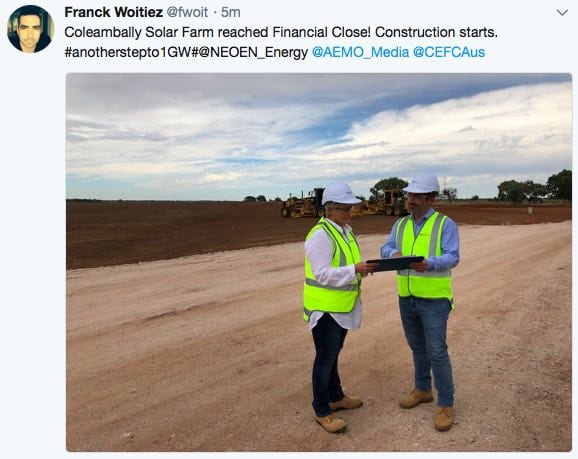French renewable energy and battery storage developer Neoen has reached financial close on its 150MW Coleambally solar project in NSW, and has begun construction barely a year from forming the initial idea.
The project, near Griffith in the south-west of the state, will join another 110MW of solar farms – in Dubbo, Parkes and Griffith – that are nearing completion by Neoen in NSW.
Franck Woitiez, the CEO of Neoen’s Australian operations, said the speed with which the project evolved from initiation and site selection to construction is significant.
“We started developing this idea a year ago. We found the land, we signed a PPA (power purchase agreement), and organised the grid connection,” Woitiez told RenewEconomy.
“Now we have reached financing and it will be in production before the end of the year. That is less than two years from idea to production.”
Woitiez says there are many projects like Coleambally in the pipeline, and all could be brought to market quicker and cheaper than a massive pumped hydro scheme like the $8 billion Snowy 2.0.
“You could build 2,000MW of solar, add storage, and provide reliable and dispathable and cheap electricity in half the time of hydro, and at a lower cost.”
That is sure to be part of an ongoing debate over the future of energy in Australia.
The federal government is proposing to intervene in the market and invest at least $8 billion in the Snowy 2.0 pumped hydro scheme, despite questions about its financial viability and its environmental impact.
But others suggest it might be better left to the market, with the right policy signals, to get the equivalent amount of reliable power, sourced from wind and solar rather than coal, and cheaper. And built across the network where it is needed.
This is the vision of network operators such as Transgrid, and the Australian Energy Market Operator, which has recommended the creation of a series of renewable energy hubs (including in NSW), as part of its Integrated Supply Plan that we reported on in December (and which has suddenly be taken up by mainstream media).
Neoen is the owner of the Tesla big battery, officially known as Hornsdale Power Reserve, which is located next to its 305MW Hornsdale wind farm in South Australia.
Woitiez says the battery has been performing “beyond expectations” in its first two months. He said Colleambally is capable of adding storage, but no decision has been made yet.
The Coleambally solar farm signed a 12-year PPA with EnergyAustralia last year – for 70 per cent of the output – although the price details of the contract have not been released (they never are).
The project has also received $30 million in debt finance from the Clean Energy Finance Corporation, which noted that NSW has the largest electricity demand in Australia, but a relatively low penetration of large-scale solar generation.
CEFC also provided a total of $150 million finance for the 110MW of projects at Parkes, Dubbo and Griffith that also received funding under the large scale solar program led by the Australian Renewable Energy Agency.
Those projects are now connected, and waiting final permissioning, after having to overcome new rules imposed by AEMO on the performance of large scale solar farms and their ability to ride through voltage swings.
“We are pleased to support Neoen’s investments in the construction of new solar generation in New South Wales,” CEFC Large-Scale solar lead Monique Miller said.
“As well as driving lower emissions and regional employment, these investments are delivering renewable energy to large population centres.”
EnergyAustralia’s head of energy Mark Collette congratulated Neoen on reaching financial close for the project.
“The Coleambally solar farm is a great example of the projects that will underpin a modern energy system in Australia. We’re proud to be partnering with Neoen to bring it to market, so households continue to receive affordable, reliable and cleaner supplies of power,” Collette said in a statement.
The Coleambally Solar Farm is five kilometres north east of Coleambally, and 70 kilometres south of Griffith. The development is part a growing stable of NSW solar projects developed by Neoen with CEFC finance.
Neoen also received finance from European based financial institutions NORD/LB and KfW Ipex.









